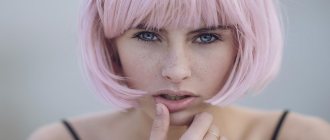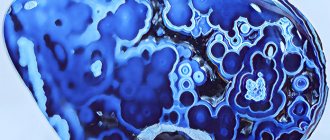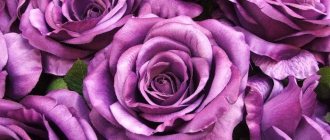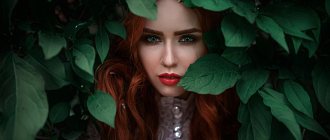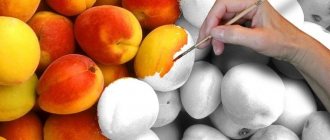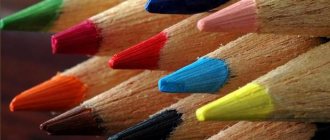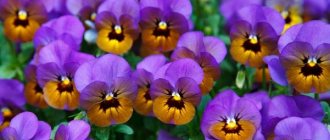The first associations that blue color evokes for most are the sky and water. Looking at it, it’s like feeling the breath of a cool breeze on a clear summer day. It is believed that the name of this color in Russian comes from the word “dove”. Another version speaks of its connection with the word “depth”.
Visually, blue appears to be a lighter variation of blue. However, from the point of view of physics and coloristics (the science of colors), this is not entirely true. Light blue is a mixture of blue and green in different proportions. A huge number of sayings and catchphrases are associated with this shade. It can be called one of the most mysterious flowers, and we will try to reveal all its secrets in this article.
The meaning of blue color in psychology
The ability to have a calming effect on the human body has led to the fact that this color is often used by psychotherapists when working with aggressive and hot-tempered patients. It is easily perceived, helps to relax, improves intuition.
For men
All heavenly shades are preferred by romantic men. Their mood may change frequently, and sometimes they are overly restless and fussy.
For women
Women who prefer this color are purposeful and selfless. They are always ready to defend their opinion.
If such colors predominate in a girl’s clothing, then it indicates her high spirituality, seriousness and ability to achieve her goals.
Being in a room painted in shades of blue helps a woman relax, calm down internally and extinguish unnecessary emotions.
For children
This color is associated with freshness and lightness, therefore it has a positive effect on the fragile child’s psyche and body. Such shades help the child calm down and relieve stress after a stormy day. Don't get too carried away, because... oversaturation with this tone leads to a feeling of coldness and alienation.
What does the color blue mean, the craving for this color in human psychology, how do they affect the psyche?
- What does this cold, but at the same time so attractive blue color mean? It means peace, tranquility, wisdom and faith. This color also symbolizes relaxation and forgiveness.
It is important to say that the blue color has a huge number of tones, or to be more precise, 180.
Of course, we will not analyze the meaning of each shade, but we will still say about the main ones:
- Blue. This shade symbolizes carelessness and reliability. It has a calming effect on the nervous system, however, it does not concentrate our attention at all. It is also generally accepted that this shade symbolizes peace and a cloudless future.
- Indigo. This shade is distinguished by its depth, it is thoughtful, emotional and restless. Very often, this color can have a not entirely favorable effect on our psyche; it can provoke a nervous disorder or an emotional outburst. Sometimes the color indigo is identified with sadness and depression. This shade also symbolizes space, the mysteries of the universe, etc.
- Turquoise. This shade is bright and joyful. It can greatly influence a person, however, more often positively than negatively. This shade of blue instills confidence in a person and gives him strength to achieve his goals. It also helps to survive loss and grief, instilling optimism and faith in a person.
Psychology
From a psychological point of view, blue color has the following characteristics:
- Confidence, courage , ability to resolve conflict situations, reluctance to conflict and sort things out.
- Inflexibility , the ability to defend personal opinions, your views on the world around you and the rules, the ability to not pay attention to what others say.
- The desire to always do everything perfectly, idealization of the world and everything that happens around.
- Increased concentration, responsibility, determination.
- The predominance of reason over emotions, the ability to restrain emotions, behave calmly in any situation, restraint.
- The ability to value traditions, loyalty, devotion.
Well, now let's talk about why sometimes a person experiences a real craving for the color blue. Psychologists say the following about this:
- People who have a liking for the color blue sometimes lack confidence in themselves and their abilities. Blue color can give a person a feeling of confidence and reliability.
- A thirst for this color awakens in people who are overly emotional . This happens for the reason that the subconscious and nervous system give a signal to the body, literally asking it to reduce emotionality and tension. Blue color perfectly calms and normalizes the nervous system.
- Desire for stability. When various troubles and problems occur in a person’s life, he subconsciously wants to solve them faster and consolidate his position.
Color
The following can be said about people who prefer blue in everything and their character:
- The character is quite complex, but strong and strong-willed. People who love the color blue are distinguished by their tenacity and ability to defend their point of view. It is difficult to convince such a person of anything; he absolutely does not care what other people say about his views on life and actions.
- Despite the above, such people are very fair and objective . They respect other people's opinions, do not try to convince someone of the correctness of their opinion, and always objectively evaluate both their own actions and those of others.
- Connoisseurs of blue are diplomats . They know how to find a common language with all people, they know how to get what they want without damage to both parties. They do not accept conflicts and showdowns, especially in raised voices. They believe that any situation, no matter how difficult it may be, can be resolved calmly and peacefully.
- They tend to do everything better than everyone else. They have excellent student syndrome, they very often push themselves because they always want to be the best, the first.
- Endowed with good intuition, sometimes extrasensory abilities. These people are very sensual and sensitive, often hiding a very vulnerable nature under their strong character.
Blue lovers are loyal and reliable, these qualities are manifested in all areas of their lives: family, work, friendships, etc.
- However, in addition to good character traits, people who love the color blue also have bad qualities. The main ones include rancor, emotional instability due to the desire to always control everything, to succeed, etc., and to some extent selfishness, since very often such people put their interests and priorities above everything else.
Blue color also has a certain effect on our health:
- With prolonged contact with blue light, a person’s blood pressure normalizes and heart rate returns to normal.
- also returns to normal , the nervous system begins to work correctly.
- With the help of blue color you can relieve stress, relax, unwind , and speed up the process of falling asleep.
- Blue color also helps to concentrate, improves brain performance and memory.
- However, it is important to remember that everything is good in moderation, so an excessive amount of blue in a person’s life can lead to depression, depression and bad mood, especially when it comes to dark blue.
Natural shades and pigments
This color is rarely found in nature.
It is most common among minerals, precious and semi-precious stones:
- larimar and aquamarine - stones come in both blue and greenish colors;
- topaz, it acquires this color due to the presence of titanium ions in its composition;
- turquoise, most often it has a greenish tint, but depending on the place of origin, blue specimens are also found;
- lapis lazuli, this mineral is most often blue, but occasionally blue stones are also found.
It is believed that all stones of this color have healing properties and have their own meaning.
Unique turquoise stone.
How do you get blue color?
Few ancient civilizations knew how to distinguish between blue and light blue, only the Egyptians knew how to obtain and use these colors correctly. In nature, such a pigment is rare, so representatives of ancient culture called it the color of the sea or sky. The air looks this way because the process of light scattering occurs.
Despite the fact that this color is rarely found in nature, it is often used in various fields: art, industry, etc. For example, to obtain fine porcelain with the required shade, the Chinese added bluish cobalt to the clay.
Europeans combined oxides of iron, copper, and calcium and as a result obtained blue pigments. They were used in painting churches, creating stained glass windows, etc. In the 19th century learned to make synthetic pigment, which was cheaper and more accessible.
When creating this shade, we must remember that this is a tone of weak saturation, so add a blue color to the white paint. The result is the desired color, which will vary depending on the proportion. Classic blue is formed by mixing equal parts of blue and white paint.
Blue lovers
What color a person likes can tell a psychologist a lot about his personality. The psychological portrait of a person who loves blue includes the following features:
High intellectual potential. Balance, restraint in expressing feelings. The ability to reason soberly even in a tense situation, following the voice of reason rather than the heart. Personality harmony, self-confidence. Developed intuition, insight. Strong and decisive character, dedication, effectiveness. Non-conflict, ability to find compromises. Tendency to meditate, reflect, and withdraw into oneself. Closedness, but within reasonable limits. Limit your circle of friends to a few truly close ones.
Fans of this color have excellent creative abilities and an aesthetic perception of the world. They prefer peace and quiet rather than noise and fun.
Negative traits of blue lovers are impressionability, vulnerability, painful reaction to criticism, sometimes gloom and despondency, melancholy
By profession, people who like this color are often associated with the sea or sky. They often become pilots, flight attendants, sailors, air traffic controllers, or serve in the Navy or Airborne Forces. Their developed intelligence often forces them to try themselves in science and research. And those who have a stronger creative streak become artists, musicians, clothing, interior, and landscape designers.
Physiological effects of blue color on humans
Any color has its own physiological effect on a person. If you suddenly start liking shades of this tone, it may be a sign of stress and fatigue, indicating that rest and relaxation are needed.
This color helps to calm down, but unlike other cold colors, it does not cause inhibition. A person looking at such a palette reduces temperature, mental stress and relaxes muscles, which leads to increased resistance to stress.
Positive influence
For most people, blue and its shades have a positive effect, so they are often used in the design of educational institutions to increase creativity and creativity in students.
For example, lavender and cornflower blue colors have a positive effect on the thyroid gland, helping to more effectively fight high blood pressure and various inflammatory processes. Turquoise, it is used in the treatment of mental patients.
The following positive qualities of this color are noted:
- reduction of irritability, aggressiveness and dissatisfaction;
- improved attention and ability to organize thoughts;
- strengthening feelings and activating fantasy;
- correction of the condition of a patient with mental illnesses (neuroses, insomnia, various phobias);
- increasing stress resistance;
- temperature drop;
- decreased heart rate;
- dulling of pain;
- increasing muscle tone.
Blue color has a calming effect on the nervous system.
Negative impact
Here, as in any other case, the main thing is not to overdo it. Some people associate too much blue with coldness and lack of feelings. Such an environment can lead to apathy and indifference. To avoid the described consequences, you need to harmoniously combine colors when decorating the interior.
Emotional sphere
Most people associate this color with the sea and sky, so it always evokes only pleasant and joyful feelings.
Every person should be surrounded by a blue color, because... it helps to calm down, become more loyal and compassionate towards others.
A workplace decorated in this color encourages productive and efficient activity. Athletes often use clothes of this color, which helps them show better results.
Main characteristics
Many people believe that this is the color of carelessness, lightness, and airiness. It personifies purity of motives and carelessness, calmness and even passivity. Others say it symbolizes indifference, coldness and detachment. One of the descriptions is the high intelligence, good manners, tact and creativity of a person who prefers aquamarine. The walls of educational institutions are painted blue to arouse in children the desire to learn and learn.
It has hundreds of shades, including:
- heavenly;
- azure;
- turquoise;
- cornflower;
- sea wave;
- aquamarine;
- topaz;
- gray original;
- the color of the water of Bondi Beach;
- "Tiffany";
- marshmallow;
- sapphire.
Such an impressive palette encourages contemplation, awareness and the formation of harmony with the world.
Attitude to the color blue
No two people are alike, so everyone relates to the specified color in their own way. This will depend not only on the psycho-emotional portrait of the person, but also on the situation in which he finds himself.
If you like the color
People who love this color are often called "artists." This is not related to their type of activity, it implies that they are open, sociable and optimistic. These are dreamers, travel lovers who are not afraid to change their usual environment. Often these are creative individuals, but at the same time they
trying to turn it into a business. There are many fans of this color among scientists who strive to explore the world around them and are drawn to the supernatural.
If blue is unpleasant
There are some people who, due to their character traits, are among those who do not like all shades of this tone.
Features of this category:
- aggressive and unbalanced behavior;
- inability to manage your emotions and words;
- the desire to constantly be on the move;
- making decisions under the influence of momentary emotions and feelings;
- irrationality and lack of composure.
If you like blue: what does it mean?
There is a close connection between a person's temperament and their color preference. That is why blue color can give a detailed description of a person.
- Those who love this color are united by a love of creativity. Moreover, these are not easy hobbies; people strive to turn them into a business and use them to increase their income.
- Azure is preferred by intellectually developed individuals, often working in the field of science. They are eager to know and explore, and gravitate toward the supernatural. Among them are humanists and lovers of technical subjects.
- Those who love the heavenly have an even emotional background, make decisions with a clear mind, rarely relying on the heart and feelings, are always balanced and adequate.
- These are purposeful people, focused on a specific goal, who correctly set priorities in order to achieve the desired results in the shortest possible time. Women who prefer blue devote more time to their careers than to their families.
- Despite the inability to show high feelings and radiate clear emotions, lovers of azure are very vulnerable individuals who suffer failures with pain and can become depressed when a “black streak” appears. Almost all representatives are pessimists and realists.
- Women and men who prefer this color spectrum are perfectionists. This is a deep, perfect shade, like it, people constantly redo something, try and are rarely satisfied with the result.
- They are characterized by antisociality. These are sociable and sociable people who, however, prefer a narrow family circle and quickly get tired of being in a crowd for a long time. They cannot stand loneliness, but they also do not waste time making dozens of new acquaintances.
Symbolism of color
In most world cultures, this color is considered a symbol of calm and peace.
Major religions view it differently:
- Christianity. All Christians are sure that the color of the sky induces humility and piety. The Virgin Mary is often depicted in a blue cloak, and Catholics present her with blue flowers. They symbolize purity, integrity and devotion to God.
- Buddhism. Here this shade is a symbol of motherhood, love and compassion for one’s neighbor. For them, it is associated with harmony, tranquility and spirituality.
- Judaism. All shades of this color symbolize holiness.
- Islam. For Muslims, this color is associated with mourning and sadness.
In ancient Rome, rich people painted blue veins on their arms and legs to emphasize their divine origin.
Christian clergy in colored robes.
What does it mean, symbolize and what is associated with?
Cyan is a light shade of blue. Quite common in nature , therefore it is perceived by the human psyche as natural and safe.
It has a wide range of shades, the most famous of which are ultramarine, pervanche, turquoise, azure, and sky.
Interesting information about the color blue:
- Orthodoxy is personified by the color blue with the Virgin Mary.
- The common phrase “blue dream” means a beautiful dream that is almost impossible to achieve.
This is due to the fact that blue has long been considered a color that signifies perfection and dreams. - Topaz represents the color blue.
- Blue is the specific gray color of cat fur that is characteristic of certain breeds, for example the Russian Blue cat.
- Blue nevi (moles) are sometimes found on people's skin. They can sometimes be dangerous, but in most cases they are harmless, although they are more likely to develop into melanoma than regular brown moles.
The most common association with the color blue is the sky .
The skies in sunny weather are painted a rich blue color, sometimes fading into blue.
Clear skies have long been considered a good sign, since they did not foreshadow troubles in the form of thunderstorms, hail, or snow that could seriously complicate the lives of people of the past.
A large number of flowers are colored blue, for example cornflower, chicory, scilla, delphinium, forget-me-nots, blue flax, some varieties of plants such as lilac, poppy, bells, petunia, iris, ageratum.
Many people, when thinking about the color blue, will remember Malvina’s hair from the children’s fairy tale “The Golden Key” and her prototype - the Blue Fairy from “Pinocchio”. These two characters serve primarily to push the protagonist towards the light.
Blue color is the personification of peace, hope, goodness, light, intelligence, calm, confidence, happiness, fidelity, security, inspiration, spirituality, dreams, harmony, creativity, wisdom and the desire for knowledge.
This is a light and cozy color that rarely evokes negative emotions in people.
What does the color blue mean in psychology? Find out about it in the video:
Geography of blue - widespread use in home decoration
This color is often used when decorating houses, but it must be taken into account that its meaning varies in different countries. For example, in China this shade means immortality, in America it is associated with masculinity, in Japan - with deceit and meanness.
In Morocco, windows and doors are painted this color, because... it is believed to protect against evil spirits. This country is home to the bluest city on Earth - Chaven. Here, most of the houses are painted cobalt.
The positive influence of blue on a person’s psychological state is often used when decorating houses.
A siding roof of this color not only looks beautiful, but when people look at it, their blood pressure, breathing and muscle tone normalize. A house decorated in such colors is well suited for creative and romantic people.
When choosing this option, it is necessary to take into account that on a hot day, this design gives a feeling of coolness, but during the cold period it increases the feeling of chilliness, so you should not overdo it when using it.
Decorating a home in blue tones has the following advantages:
- visually strengthening the walls of the house, giving them grandeur and monumentality;
- reflection of sunlight, which is especially important in the southern regions;
- combination with bright and rich colors;
- slow fading in the sun, so the house retains its attractive appearance for a long time.
What does dislike of color mean?
Certain character traits are also present in those who dislike blue , such as:
- Aggressiveness, imbalance. It is difficult for them to control themselves, they easily explode and cool down just as easily. Such people are overly active and strive to do as much as possible.
- Impulsiveness. They quickly make decisions, guided by emotions rather than reason; they can hardly be called rationalists.
Also, people who do not like the color blue are falsely called dreamers .
What does the color red symbolize? Find out the answer right now.
Using the color blue in healing meditations
This color helps in the treatment of various diseases. It refreshes well, relieves headaches, and reduces appetite, which is important for those who want to lose weight.
According to experts who practice color therapy, shades of this tone help reduce blood pressure, normalize sleep, and get rid of heartburn, diarrhea and vomiting.
For women, wearing this design reduces the amount of bleeding during menstruation and neutralizes PMS symptoms. It helps overcome shyness and self-consciousness.
Color healing has been used for a long time, dating back to the formation of Persia, Egypt and China. Each tone has its own effect on the body. Being in a room painted in blue tones helps fight thyroid diseases, activates sweating, lowers body temperature, which leads to the elimination of waste and toxins.
The effect of blue on health
Color therapy is a method of alternative medicine in which a colored color is applied to the patient in a certain way. Blue is popular in this area due to its abundance of beneficial properties.
Benefits of blue for physical health:
Slows down breathing and reduces heart rate. Reduces blood pressure, helps prevent heart and vascular diseases. Prevents sleep disorders. Reduces muscle tone, relaxes muscles. Acts as an analgesic, including for rheumatism, headaches and menstrual pain. Relieves inflammatory processes in the body. Improves the condition of the digestive system, relieves heartburn and diarrhea. Facilitates well-being with sore throat, measles, burns, allergies. Relieves visual tension.
Mental Health Benefits:
Reduces emotional stress, relaxes. Relieves obsessions. Relieves nervous attacks. Prevents attacks of hypochondria. Restrains attacks of aggression and neuroses.
Finally, color perfectly stimulates intellectual activity, improves thinking and memory, promotes the development of imagination and flight of fancy.
Researchers note that blue color is useful to “inhale.” To do this, you need to collect blue flowers and put them in a vase in the bedroom, next to the bed.
Interesting facts about the color blue
This color has many shades, it evokes pleasant associations, so it has quite a lot of fans.
Some interesting facts about him:
- Blue and its shades are the favorite color of almost half of the entire population of the planet. It appears on many national emblems and flags.
- In Ancient Rome, this shade was a symbol of deceit and was associated with troubles. People with blue eyes were considered inferior. In Ancient Egypt, on the contrary, this tone is a symbol of noble origin.
- The familiar color of the sky is associated with an effect called Rayleigh light scattering. Blue waves are shorter in length than red ones, causing them to spread more widely.
- Morpho butterflies have blue wings. This is achieved not due to pigment, but thanks to the scales through which sunlight is refracted and such an illusion is created.
- It used to be that aristocrats had blue blood. This is a metaphor for people, but some mollusks have blood of this color. In the octopus, this color is given by the pigment hemocyanin.
Beautiful Morpho butterflies.
Origins
Most language researchers agree that “blue” is derived from the word “dove.” The bluish color of this bird is one of the most pleasant shades of blue combined with gray. According to another version, the name goes back to the word “depth”.
The color is a combination of deep blue and crystal white, sometimes with a shift towards green. Interestingly, blue tint is rare in nature. For example, a cloudless sky does not have this hue at all, but appears blue due to the scattering of ultraviolet rays. And sea waters are often clear, not blue. In nature, blue and its shades are found among minerals and precious stones: sapphire, topaz, lapis lazuli, aquamarine and spinel.
Blue tones
In its pure form, this color refers to cold tones, but if you add a little yellow to it, it acquires a warm tint.
Cold
Basic cold tones: protective blue, cornflower blue, azure, etc. They have a metallic tint and are dark in color. People who prefer such colors strive for variety, new adventures and self-improvement. They are characterized by a passion for religion and meditation, and they often become sailors or military men. Such people strive to get the most out of life.
Warm
The warm tones of this color include heavenly and all its varieties. Preference for light, pastel colors indicates a sociable and open character.
Such people cannot stand loneliness; they suffer from depression, boredom and a feeling of emptiness. Lovers of the warm tones of this color scheme have many friends with whom they are always ready to share their material and spiritual values.
Variation of characters depending on tone
All people have their favorite color. Some people like two or three different shades. Using them, you can give a certain characteristic of a person, find out hobbies, goals and mindset, level of emotionality. Therefore, it is important to know what the color blue means and symbolizes. Those who like him are very bright and impressionable people who have managed to preserve their childlike spontaneity. They are prone to carelessness, sudden changes in mood, they can be very happy, and after a minute they become despondent and bored. They are characterized by a change of place, a desire to change the environment. They are capable of strong, sincere love and experience true happiness and satisfaction.
This is the color of creative and creative individuals, and not necessarily actors, artists or pop performers. These are playful, passionate men and women who strive for success, recognition and creating beauty around them. The shades of the heavenly can tell more precisely:
- Light, pastel colors indicate sociability and openness. Those who prefer it do not like loneliness, often suffer from feelings of emptiness, boredom and depression. They have a large social circle, where they give everyone maximum attention, both material and spiritual.
- Cold, metallic, dark characterize the attraction to diversity, self-improvement, new cities and countries. People are interested in everything unusual and even mystical. They can fall into religion or go high into the mountains for meditation and yoga, or choose the profession of a military man or sailor. They take everything from life, bathe in luxury and recognition.
All bluish shades distinguish self-sufficient people who know themselves well, know how to control, say “stop” at the right moment, and strive for harmony, order, silence and stability. Those who do not like this color crave change and constantly live in anxiety.
Psychologist Daria Milai
Make an appointment
Shades of blue
The whole variety of warm and cold tones is divided into a number of shades, among which the most popular are:
- pale blue is the lightest shade, the white undertone dominates here, which has a positive effect on the psyche and has a calming effect;
- steel blue - it is close to purple, but has a bluish tint, is actively used in interior design, and is a symbol of determination;
- light glaze is a symbol of wisdom and infinity;
- turquoise – refers to deep warm tones, personifies purity and innocence, uplifts the mood;
- cornflower blue is pale, its undertone is the most delicate of the palette of this color, it is associated with romanticism and lightness of thoughts;
- cobalt - named after the corresponding metal, symbolizes confidence and harmony;
- lavender - personifies mystery, tenderness and mystery.
How many of them exist in different palettes
There are 119 shades of blue in the Pantone system. Using the appropriate table, you can find your favorite shade and find out its correct name. This will help expand your understanding of the diversity of this color scheme, and the knowledge gained can be used at your discretion.
There are several popular color models (mathematical system), with the help of which all shades are encoded differently:
- RGB (Red, Green, Blue). Here different amounts of these colors are added to black. The heavenly shade is obtained using 11% red, 67% green and 84% blue. In RGB, everything is counted in absolute values (from 0 to 255), it turns out that this color is designated as rgb (28, 170, 214).
- CMYK (Cyan, Magenta, Yellow, Key). In this model, any shade consists of a combination of blue-green, purple and yellow. Here, different numbers of the described colors are subtracted from white. Celestial includes the indicated colors in the following ratio: cmyk (86%, 20%, 0%, 16%).
- HEX – hexadecimal model. Here the designation consists of numbers from 0 to 9 and letters from A to F. The 6 symbols used in pairs are responsible for the red, green and blue color. In this system, celestial is designated as 1DACD6.
- HSV - in this system, color is described as light of a given hue and saturation. Heavenly is designated as hsv (194, 0.86%, 0.84%).
- HSL - color description occurs as light belonging to a given tone. In this case, celestial would be written as hsl (194, 76%, 48%).
All shades of blue.
Pastel shades
Such tones are also called pale or muted: steel, gray, pale blue, etc. They have a relaxing effect and are often used as a background.
Bright colors
They differ in saturation; the most common colors are azure, turquoise, topaz. They help create a festive and joyful atmosphere.
Dark shades
You have to be careful with them, because... an overabundance of dark tones can cause a feeling of dejection. When decorating a room painted in dark colors, only certain items can be present.
Psychology of color perception
https://ledokol.ua/ru/brandhelp/psihologiazveta
Associations caused by color Psychologists have long established that color significantly affects a person’s psycho-emotional perception of various things. After all, colors appeal to feelings, not to human logic. When creating a design, be it the corporate identity of a company or the packaging of a new product, you need to take into account a certain relationship between the color scheme and the natural perception of it by a person. Everything should work towards the goal - to attract attention, interest, evoke the right emotions. When developing logos and other graphic elements, we proceed from the fact that the image we create must have visual strength and harmony. The importance of color in advertising is enormous. A well-defined task and the professionalism of the designer are important components in the success of any project. How consumers perceive your product depends on many factors. The design and color of the packaging, as is known, determines the buyer’s first impression of the product. Color can attract and repel, instill a feeling of calm and comfort, or, on the contrary, excite and disturb. Each color has its own psychological subtext (meaning). The information provided here is general, without a detailed analysis of the impact of a particular color on a person. It should also be taken into account that in different environments the same color can be perceived differently: for example, a red spot on a white, neutral gray and yellow background will be perceived differently.
Yellow Yellow is a bright, stimulating color that increases concentration, improves memory, organizes, and promotes quick decision making. Helps understand new ideas. Yellow is the color of the sun, energetic, but without aggression, the color of optimism, freedom, openness, mobility, sociability. Adjusts for communication skills. This color is openness and sociability. Helps to give balance to emotions, to find inner peace, to pacify emotional excitement. People who prefer this color do not like fools, they like to be admired, they do not like to be driven into a corner. They are characterized by high self-esteem, self-confidence, and activity. The color yellow can “endow” an object with intelligence. This color will be successful in advertising high-tech products, goods for children, travel agencies, and advertising agencies. It is often used in food packaging, in particular bread, flour products, and cereals. Causes positive associations in advertising. Possible negative associations: At the level of stereotypes, there is an opinion that Yellow is the color of separation. Yellow can also evoke associations associated with jealousy, envy, condemnation of others, “The Color of Gossip” (yellow press).
Orange The color Orange in small quantities awakens in us thoughts of joy, fun and bright sunshine. Orange color releases emotions, raises self-esteem, promotes good mood, and is an excellent antidepressant. Helps to induce a surge of vitality and gives an optimistic tone. Considered the color of health and creativity. Orange color adds activity, but at the same time gives a feeling of inner balance and spiritual harmony. The main association associated with the color orange is spiciness and piquancy. It is this word that can determine our attitude towards the color orange. This color is best used in advertising medicines, products for children, health services and education. To prevent the orange color from causing irritation, you can use its various shades. Pastel orange color is close to peach - and this color in people's minds is usually associated with freshness and health, natural skin color and cosmetics. Possible negative associations: Too much orange seems brash and insolent to us. And an excess of arrogance already looks vulgar and cheap. However, there are other shades of perceived orange that many manufacturers use. The color orange is often associated with low price and availability. No wonder it is so widely used in fast food restaurant chains.
Red Of all the colors in the spectrum, red causes the most powerful physiological reaction - increased heart rate. Red color will not allow you to pass by; it immediately attracts attention and controls the situation. In nature, red is the color of abundance, it evokes strong emotions that will depend on the situation, because... associatively it can be the color of love, rage, celebration, fun. The color red represents power, breakthrough, the will to win; as a rule, it is chosen by people who always achieve their goals; it contributes to a statement of strength and opportunity. It instills decisiveness and can arouse in a person a strong desire for action, vigorous effort - for example, to buy an advertised product. Calls for attention. It also has a certain sexual charge. Possible negative associations: An abundance of red can cause irritation and even rage. To achieve harmony, it can be combined with other calmer shades, such as gray.
Pink Pink color symbolizes joy, youth, kindness, friendliness, femininity. Like red, it is the color of love and flowers. It can also be said that pink is the color of dreams and hope; stereotypically it is often perceived as feminine. People who prefer pink are usually dreamy, conscientious, but more delicate; they try to avoid disputes and conflicts. Excellent for the sphere of personal relationships: enhances feelings, makes people more attentive, affectionate and sensitive. Pink is often used in cosmetics, especially for young girls, and is the color favored by toy manufacturers; often used in advertising perfumes, products for women and children, marriage agency services, and family centers. Toys and clothes intended for girls are traditionally pink. Possible negative associations: Fragility, vagueness, weakness, frivolity. Perhaps frivolity (weakening the influence of red), putting yourself on display.
Bordeaux Burgundy color is an indicator of solidity, confidence, and conservatism. It is moderate and is associated with stability and resilience. People who prefer this color are self-confident, without unnecessary emotions, assertive but enterprising, with good organizational skills. Burgundy is considered an elegant color, which is why it is often used in the design of restaurants and furniture showrooms. Possible negative associations: Heavy, depressing. The use of this color should be moderate, because... in large quantities it can put pressure on the psyche and create depression. It can be associated with the color of antiquity, but in combination with gray it becomes an indicator of prosperity and solidity.
Purple The color of human spiritual power. Helps you focus on the main thing and inspires inspiration. He is loved by creative people, people with unconventional thinking, he is able to balance the spiritual and material. Associated with something exclusive and creative. The color violet stimulates brain function well; it is often used on packages of chocolate, raisins, and nuts. Recently, purple has often been used in the design of modern interiors; previously it was considered a majestic color, which was always present in the clothes of kings. Possible negative associations: Lightning is often depicted in shades of purple, which evokes thoughts of the supernatural and mystical. This color can be perceived in completely different ways; for some it is the color of power, spirituality and wisdom, and for others it is fanaticism, alienation and even death.
Blue Blue is the color of peace and universal harmony. This color is associated with intelligence and the ability to pacify with words. Associated with honesty, sincerity, purity, silence, coolness, but the strongest associations are the globe, water, sky, peace, ice. This is a comfortable color that evokes a feeling of well-being, security, and trust. The blue color is not as cold as blue, so being in the same range, it is more comfortable, the freshness and coolness of blue is completely different from the frostiness of blue. Perfume and cosmetics companies, as well as manufacturers of various hygiene products, actively take advantage of this psychological feature of color, using it on the packaging of their products. People who prefer this color are friendly, they know how to listen, are not irritable, and wise. Blue color tunes in to the area of feelings, but more sublime, more platonic than mundane. Blue is the color of peace and universal harmony. It makes it possible to feel an invisible connection with the Universe, and is able to give the subject a holistic appearance, and the issue/case – globality and a favorable outcome. Toys and clothes intended for boys are traditionally blue. Possible negative associations: Depending on the place of use, blue color may be considered not serious, sentimental. Sometimes it can be difficult to concentrate when looking at blue things; looking at a blue sky or looking at a blue object are two different things. Blue, like pink, is somewhat banal and stereotypical.
Blue
Blue is a concentric color, it dedicates everything only to itself. This color has “no bottom”; it never ends, pulling you into itself. Blue color is constancy, perseverance, perseverance, devotion, dedication, seriousness, rigor. It has a very strong psychological value, being the color of persuasion, but not as emotionally oppressive as red. Symbolizes eternal values, height and depth, wisdom and rigor. Dark blue color is considered businesslike, professional and authoritative - it’s not for nothing that businessmen love it so much. Helps you concentrate on what is essential. A blue detail in a catalog or advertising brochure will immediately attract attention, but unlike red, it will almost never cause negative emotions. Possible negative associations: Blue is not only the color of the sky, but also the color of the night; it can be associated with magic, strange things, witchcraft, oppression, fanaticism.
Green Green is the color of life and nature, symbolizing prosperity and new beginnings. It heals, relaxes and softens a person, so it is often used in the design of medical institutions, on the packaging of medicines, cosmetics and detergents. Green neutralizes the effects of other colors and helps dispel negative emotions. Brings calm and tranquility, helps to concentrate and make decisions. Has a strong association with spring, youth, renewal and naturalness. Possible negative associations: In large quantities it causes excessive relaxation, turning into lethargy, boredom and laziness, so it should be combined with other colors. A color that doesn’t demand anything and doesn’t call anywhere (looks past everyone). It has many shades, which sometimes give completely opposite meanings. “Green” is what professionals call an untrained person, a beginner (meaning inexperienced, young). Green color is avoided on sweet packaging because... psychologists have proven that in people’s perception the color green is “bitter” or “sour”, but not sweet. White White is the color of calm, purity and serenity. White color is characterized by perfection and completeness, demonstrating an absolute and final decision, complete freedom for possibilities and the removal of obstacles. Its fundamental quality is equality, because white contains all colors, they are equal in it. Its key meanings are: light, peace, chastity, concentration, virginity. Most often it is used as a background; all the colors on it look rich and bright. White was the color of social harmony and peace. Possible negative associations: Too much white can lead to feelings of superiority or inferiority. It can be the color of detachment, coldness, indifference.
Black
Black always hides everything it carries, being the most “mysterious” color. Balances white color (without darkness there is no light, yin and yang). Correlates with infinity, helps to concentrate and isolate oneself from all extraneous colors. In its pure form, it is used quite rarely, because... causes negative emotions. It is usually paired with warmer, brighter colors to create more contrast. Black color is classic; black suits for men are an integral part of business style. Indispensable for creating clear shapes and lines. Possible negative associations: Causes a feeling of bitterness, heaviness, despondency. Often associated with mourning. In this case, combining it with red can help; it will add dynamics and aspiration to black.
Brown Brown is the color of strength, solidity, stability, and practicality. Brown symbols: soil, tree, earth, autumn. It has abstract symbols - hard work, endurance, conservatism. Brown, along with black and navy blue, often dominates the clothing of rich and confident people, which emphasizes their sense of self-worth. Brown is the color of coffee and aromatic spices; it is exquisitely used in the interior design of coffee shops and restaurants. People who prefer this color desire physical relaxation, peace, and concentration, so it can be used in office themes. Possible negative associations: Brown color may seem boring, even depressing, and may cause associations with tobacco, smoking, and unpleasant odors.
Gray Gray color connects white and black, forming a harmony of two opposite colors. Neutral in itself, it has a subtle beauty, especially when combined with bright colors. Gray is the color of intelligence, it relaxes and helps you feel calm. It is universal and conservative, can be used in almost any field of activity to create brevity and sophistication. Possible negative associations: Gray can be associated with bad weather, illness, feelings of uselessness, melancholy, and fatigue. His capacity for peace may be replaced by a feeling of endless melancholy and sadness. It is rarely used when creating packaging for detergents, shampoos, and hygiene products, because... in the psychological perception of people, gray is the color of the city, modern offices, asphalt, dust, but not shampoos.
Golden Golden color symbolizes luxury, radiance, sun, impeccability. Represents the desire for power and demonstration of one's superiority. Gold is the color of work, career growth and wealth; as a rule, it is used in combination with other colors to give them greater significance and shine. Gold is one of the most dangerous colors; using it in large quantities can turn elegant luxury into bad taste. People like to use it on packages of coffee, tea, and cigarettes; psychologically it makes the taste “rich.” Possible negative associations: Gold can be perceived in completely different ways, causing associations of wastefulness, excessive idleness, and bad taste.
Silver Silver comes out of the gray, expresses the desire for freedom and an attempt to overcome all restrictions. Embodies nobility, safety, strength. Association words: lighting, reflection, penetration, impartiality, smoothness. Silver is a fairly cool color; it is used in small quantities on packaging; it is “more modest” than gold and, with its cold shine, adds a proud aristocracy to objects. Most often, this color is used by manufacturers of cars and equipment; thanks to its direct association with metal, silver seems stronger and more reliable. Possible negative associations: Like grey, silver can be considered a color of indifference, and due to its metallic sheen it is colder and more unapproachable. Other associations: deceit, duplicity, illusoryness.
A little about the psychology of color combinations Psychologists have found that the number of colors used directly affects the effectiveness of the advertising message. If the efficiency of perception of a black and white image is taken as 100%, then the efficiency of a two-color image increases by 20%, and a multicolor image by 40%. For advertising purposes, it is generally not customary to use more than two different colors, but they can be varied by using similar shades, as this creates a sense of color consistency and is not irritating to the eye. When creating a new product, it is very important to consider that in the future it becomes more successful if the color scheme is used correctly, which over time becomes a corporate color scheme. You must also take into account the fact that colors tend to appear one within the other. This means that adjacent colors can enhance or cancel each other out. Thus, cigarettes in a brown and white pack, due to their white color, seem weaker than those in a brown one. When they are brown-blue or brown-gold, they acquire not only a strong, but also a somewhat aristocratic taste. Sometimes several colors located nearby give a completely unexpected effect. For example, red represents energy, movement, danger, rage, and black - mystery, sadness, sadness, but the combination of red and black immediately transforms into something extravagant, piquant, alluring. But the combination of red with another, bright and emotionally rich color can look tasteless and irritate the eye. Therefore, all colors should be in harmony with each other, balance, but not suppress. The color that should carry the main psychological and emotional message should be the main and dominant one. Site map and search:
Combination of blue with other colors and shades
When combined with other colors, you get gentle and inspiring solutions. This shade helps reveal dark colors better and allows you to create different combinations.
Pink
The result of this combination is warm, gentle and light tones. The expressive and rich palette includes white-lilac, raspberry, cloudy or sunset pink.
Orange
This combination is based on the contrast of blue and orange. Unlike blue, the sky shade softens this difference, so you get a harmonious and attractive composition, for example, peach, coral, tangerine, yellow or red-orange.
Red
This pair allows you to create seductive combinations. The contrast of warm and cold tones makes the heart beat faster. Against the background of blue, red looks bright and the darker it is, the higher the light contrast and the lower the thermal contrast. Resulting colors: garnet, ruby, wine, coral red.
A clear combination of red and blue.
Yellow and gold
These colors create a natural combination that is inspiring and energizing. It is possible to create the following shades: banana, apricot, amber, bright or yellow-gold.
Gray and silver
This is a classic variation. Against a gray background, blue dominates. To get a good result, you should use not pure gray, but its more complex tones. When decorating an interior, objects are most often painted gray, and trim is blue.
Green cold and warm
Paired with warm greens makes a joyful combination. These are related tones, so combining them allows you to create light and warm solutions. These include: brown-green, pistachio, chartreuse, marsh.
Cool green is more of a shade of blue. When combined, it is possible to create additional volume.
This palette is used independently and acts as a background for warm tones. The result is malachite, jade, emerald colors.
Blue
This solution makes it possible to obtain a monochromatic range, where blue acts as a highlight and blue as a shadow. The darker the colors combined, the brighter the contrast. Such solutions include cobalt, turquoise, electric, and Prussian blue.
Violet
When this color and purple are combined, a cool and mysterious range is obtained. The thermal contrast will be light and unobtrusive. The following compositions are created: grape, violet, amethyst, purple.
Beige and brown
Paired with brown makes a unique and attractive pairing. Warm earthy color and heavenly shade are two opposites, so they complement each other well. These are colors such as bronze, coffee, chocolate, mahogany.
Beige is a neutral color, which allows it to be combined harmoniously with blue. Beige in such a composition looks more feminine and graceful, it acquires a golden color.
White and black
Blue and white are the most popular combination. This color has a calming and relaxing effect, so it is often used in interior design.
The combination with black is bold and risky. It is appropriate for a strict business design or when designing evening sets.
The most delicate combination of white and blue.
Who is it suitable for?
Blue is the color of intellectuals and creative men and women, among whom were professors, programmers, senior managers, artists, actors, writers and those who made self-improvement the basis of their existence. Blue clothes are a good solution for dreamers and dreamers. A dress will highlight a girl’s refined figure, and a tie or scarf will indicate a man who is watching him. The tone looks best in combination with white and black, light green, delicate peach, beige and cream, bright orange and discreet dark brown.
Ask a question
The use of blue color in the interior
When using this tone in the interior, consider the following:
- all rooms associated with water, such as a bath, shower, sauna, toilet, swimming pool, etc., look good in blue design;
- the relaxing effect of such shades allows them to be used when decorating relaxation rooms;
- when decorating a room facing the sunny side, this solution will help reduce the feeling of heat, stuffiness and relax;
- If you decorate a cafe in this color scheme, women will love it, because... the color is associated with sweets, desserts must be on the menu;
- When decorating sports rooms, you need to carefully use such colors, because... they slow down the psyche, cause laziness, so the effectiveness of classes decreases.
What does the color blue mean to children?
- Children are no different from adults; they can just as easily love one color and hate another. And this applies to absolutely everything: drawing, because there are children who, out of a dozen different colored pencils, always choose only black, clothes, wallpaper for the room, when the child is given the right to choose, etc.
- If your child prefers the color blue, it means he craves peace and relaxation. Most often, such children get tired quickly and therefore they need to take breaks between learning, games, etc. much more often than others.
- Often, blue lovers are very calm and balanced , they know how to play alone, do not particularly like active games, and prefer computers, reading books, watching cartoons and films.
For kids
- A child who loves this color is sensual and sensitive, he knows how to show his feelings, however, this only applies to his closest people. He is vulnerable , he can be offended because of some trifle that his parents won’t even pay attention to.
- responsible from early childhood , knows how to concentrate his attention and diligently achieve what he wants.
Lovers of blue really don’t like to do something in a hurry, in a hurry, quickly, especially if someone is standing over them and rushing them, they like to do everything calmly, measuredly, thinking about every detail and little thing. They enjoy a measured life, in which there is no place for excessive impulsiveness.
- Children who love the color blue are good and faithful companions, they know how to be friends with other children, love emotional communication, and are very worried if they inadvertently offend someone.
- If your child is the complete opposite of everything written above, but at the same time he began to pay attention to the color blue and gives preference to it, it means that he lacks peace, coziness and comfort. In this case, you need to improve the atmosphere in the house and give the child the opportunity to relax and improve his psycho-emotional state.
Use in clothing
Regardless of the combinations used to design clothes, this shade gives the image romance, tenderness and naivety. If a woman wears a lot of blue, she is most often an idealist.
An accessory of this color is suitable for both business and evening style. A monochromatic outfit may look out of place.
For the “spring” color type, light and pure tones are suitable. Grayish shades are optimal for the “summer” and “autumn” color types. “Winter” should use azure and turquoise.
Blue in clothes.
Blue color in advertising
Such shades are actively used in the design of websites, search engines and other software. This is due to the fact that they do not cause irritation.
This color scheme is often used in various advertising campaigns. This color is associated with boys and young men, and is therefore used in advertising toys and clothing for them.
To avoid boredom and monotony, blue is often combined in advertising with white, red or black. This tone is associated with cleanliness, so it is used when painting bed linen, toys, rugs, etc.
American psychology
At Harvard, doctors conducted an experiment. People were divided into several groups. One of them was left overnight in a room that was lit blue, and the other green. It turned out that the “residents” of the green room do not feel as comfortable and good as those who spent time in the next room (with blue lighting).
Blue color is “born” for timid people who feel fear. There is no need to allow the color blue to be too much, since its excess will certainly lead to scandals, quarrels and manipulation of people. By the way, legends say that a too “flashy” blue color puts a person in a state of horror, causing ghosts and spirits.
Those who persistently reject the color blue acutely feel a lack of teamwork and friendships. Such people are weak, ambitious, but striving for superiority. Quite often, the blue color is strongly rejected by people suffering from nicotine addiction and by those who are not truly understood by their loved ones.
What does the color yellow mean in psychology? Meaning. Black color in psychology. What does it mean? Meaning. The meaning and characteristics of the color purple in psychology Psychology of color in the interior. Color combination, choice, selection. Male and Female psychology of relationships and Love Psychology of color in advertising Psychology of men in love. Does a man love? Psychology of color in clothing Psychology of communication with girls and guys.
